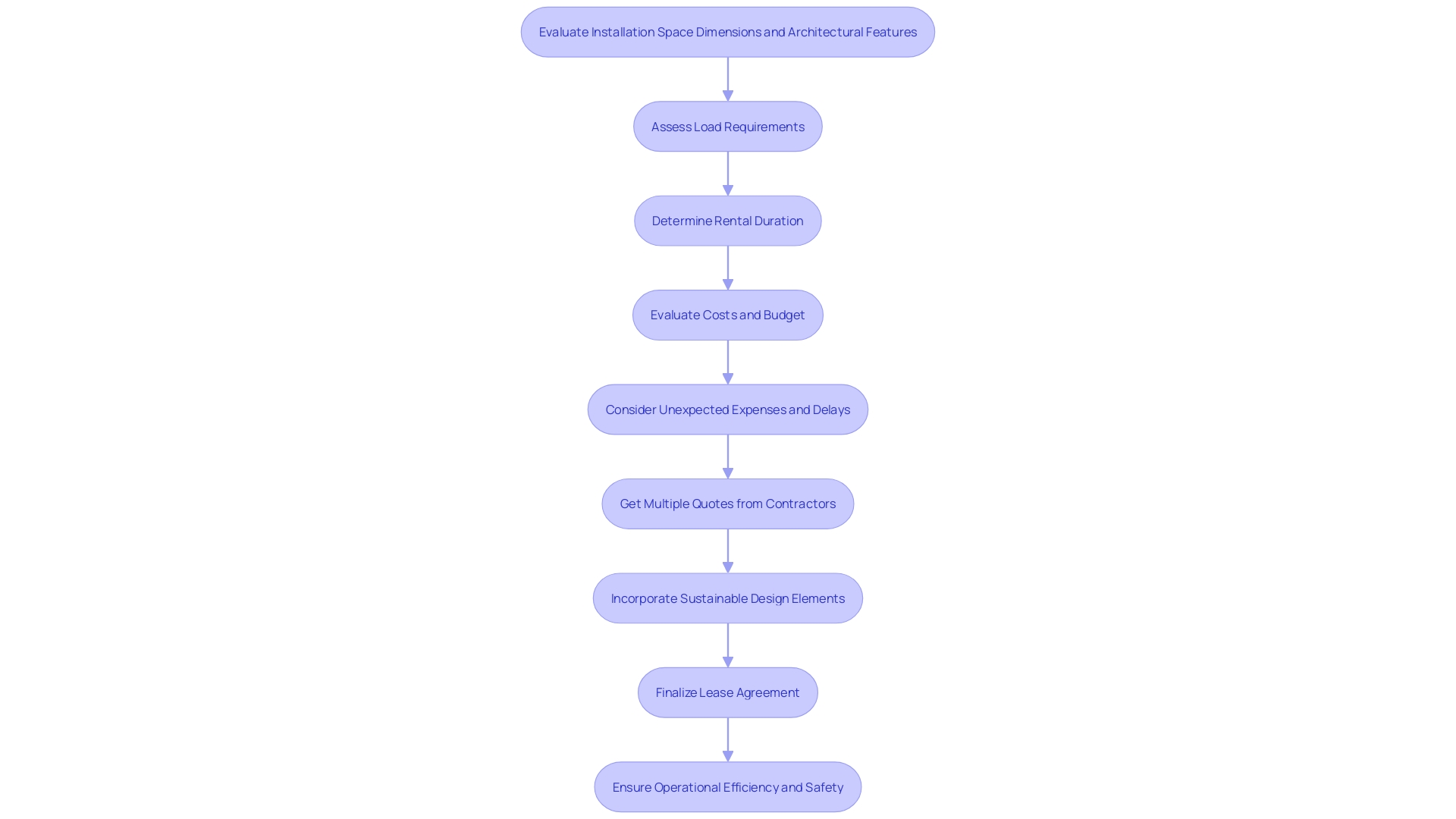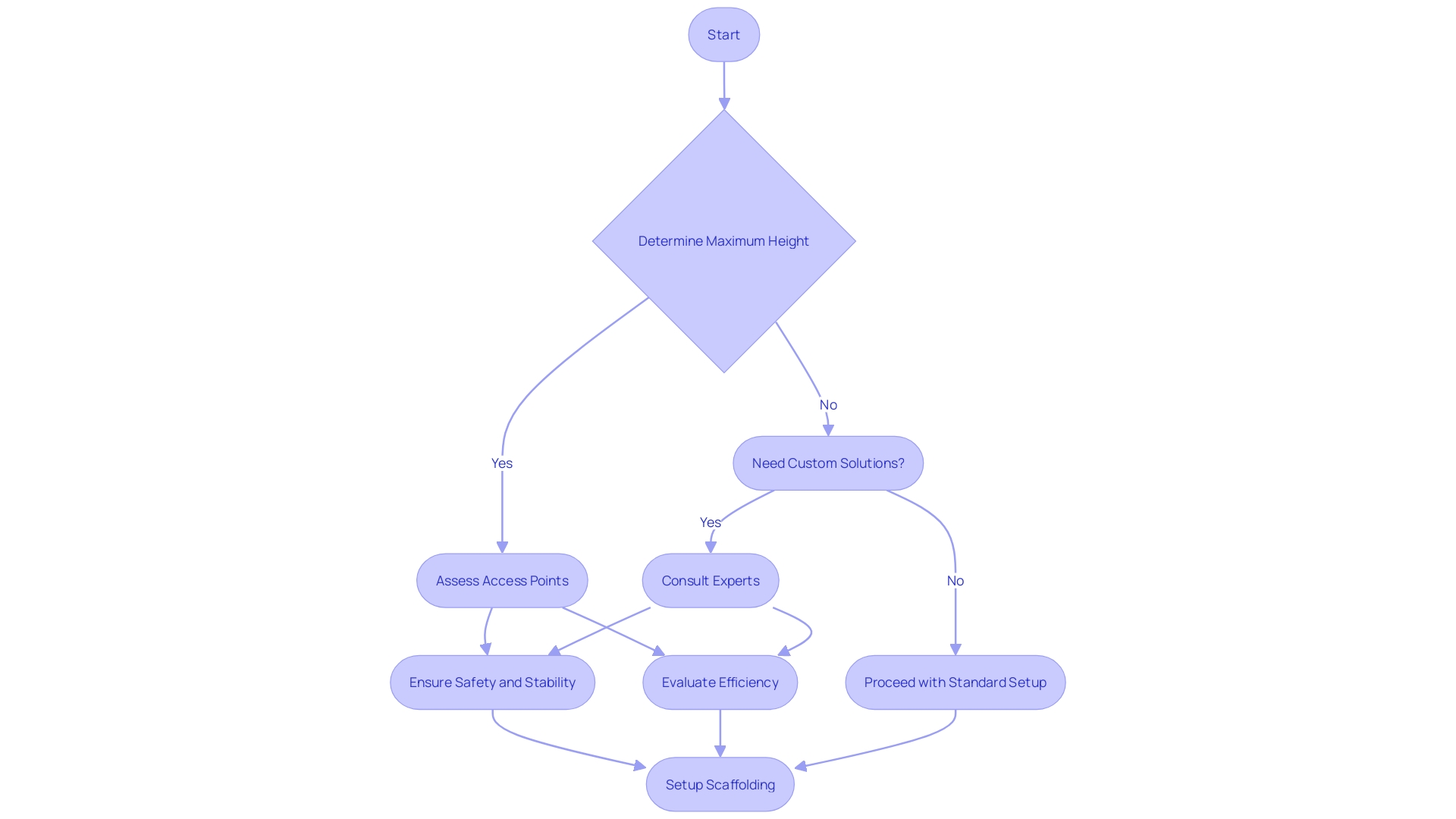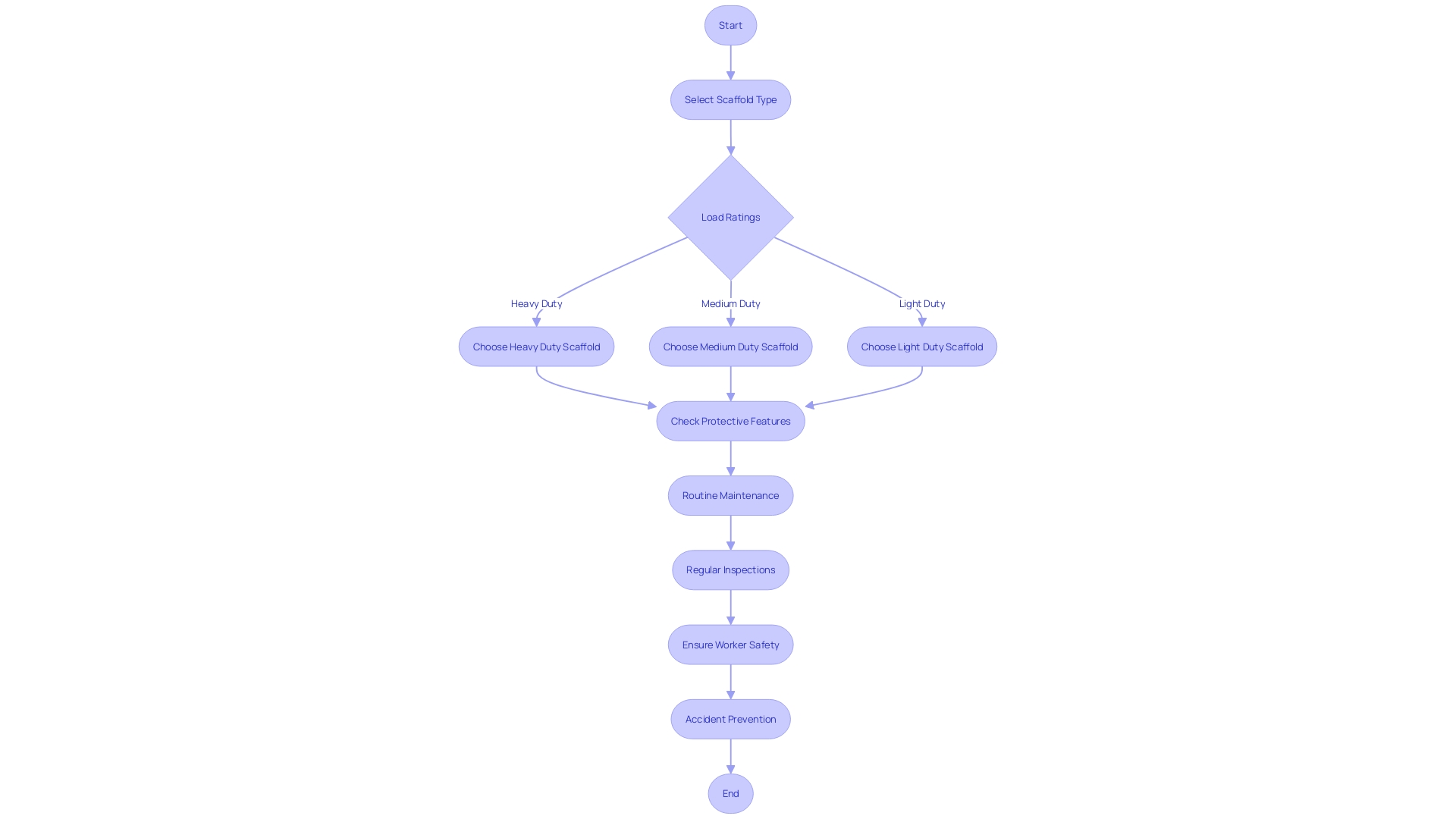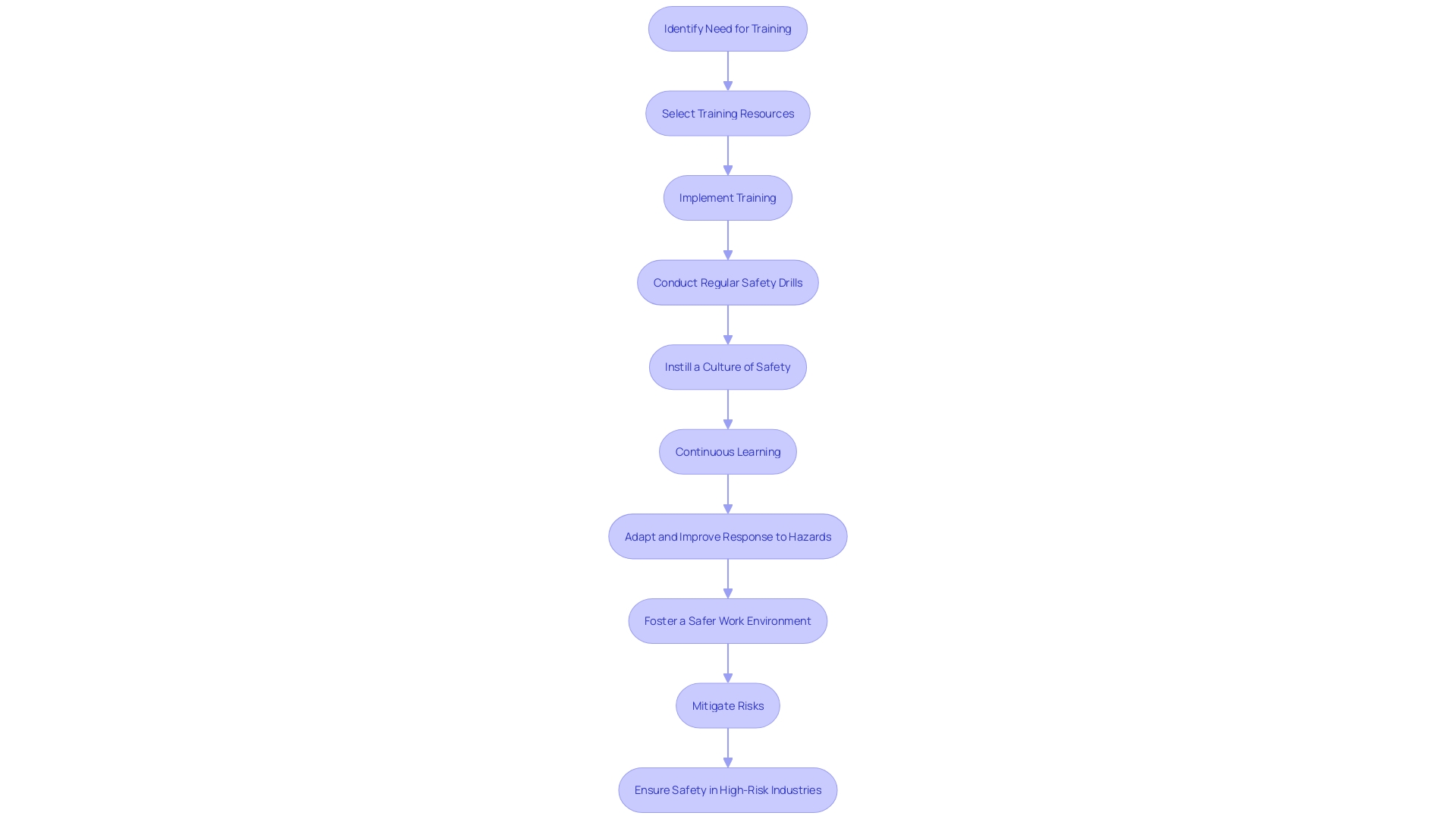Introduction
Renting indoor scaffolding can be a daunting task, with numerous factors influencing both the efficiency and safety of a project. From evaluating the dimensions of the installation space to assessing load requirements and selecting the right type of scaffolding, each decision plays a critical role in ensuring a successful outcome. This article delves into the essential considerations for indoor scaffold rentals, including the types of scaffolding suitable for various indoor projects, height and access requirements, load capacity, and the importance of safety features.
Additionally, it provides guidance on choosing a reliable scaffolding rental company and emphasizes the significance of safety training for all personnel involved. By understanding and addressing these key aspects, project managers can make informed decisions that enhance both operational efficiency and safety on the job site.
Factors to Consider for Indoor Scaffold Rentals
When leasing interior scaffolding, it's essential to take into account various elements that affect the task's efficiency and security. Start by evaluating the dimensions of the installation space and any architectural features that might restrict access. For instance, the geometric forms and material choices that engage with existing constructions, like integrated furniture or overlapping stairs and ramps, necessitate accurate measurements and field verification to guarantee compatibility and security.
Next, assess the load requirements by considering the materials and tools that will be used on the scaffold. This step is vital to prevent overloading and ensure stability. "Furthermore, the rental duration should correspond with the timeline of the endeavor, considering any particular requirements, such as height limitations or the capability to navigate around current structures.".
'These considerations are not just about meeting immediate objectives but also about enhancing operational efficiency and safety measures.'. According to specialists, performing a comprehensive evaluation of these elements assists in making informed choices that align with budget limitations and long-term requirements. By focusing on these specifics, you can guarantee that the framework arrangement aids favorably in the achievement of the endeavor.

Types of Scaffolding Suitable for Indoor Construction
Indoor tasks necessitate thoughtful evaluation in choosing the suitable support structures to guarantee both safety and efficiency. Rolling scaffolds are perfect for tasks that demand quick access and mobility across expansive areas, thanks to their wheels and ease of movement. 'Frame support structures, on the other hand, are recognized for their durability and capacity to manage heavier weights, rendering them appropriate for undertakings involving significant material handling.'.
System support is notable for its adaptability, able to be arranged to fit different forms and dimensions of constructions, which is especially advantageous for intricate indoor tasks. For specialized tasks like painting or drywall installation, hanging scaffolds provide a unique advantage by allowing workers to reach elevated areas without the need for extensive ground support.
Ensuring the appropriate kind of support structure is used not only enhances project efficiency but also significantly reduces the risk of accidents. High-quality materials and adherence to safety standards, such as those set by OSHA, are critical in maintaining structural integrity and stability. Regular inspections and maintenance further contribute to a safe working environment, preventing potential hazards.
In line with modern construction trends, incorporating sustainable practices in support structures can also reduce environmental impact. Utilizing eco-friendly materials and implementing waste management strategies can make a significant difference in the overall sustainability of a project. Embracing these advanced support solutions and practices can help satisfy the increasing needs of the construction sector while emphasizing safety and environmental responsibility.

Height and Access Considerations for Indoor Scaffolding
When leasing support structures for indoor use, height and access are paramount factors to consider. Evaluate the maximum height needed for your undertaking and make sure the scaffolding can safely reach it without compromising stability. Pay attention to access points like doorways, staircases, and narrow hallways that could restrict scaffold movement and setup. For instance, the geometric shapes and material choices in certain endeavors respond to existing built-in furniture, requiring precise measurements and field verification to ensure consistency. Custom solutions might be necessary for tight spaces, and discussing these needs with the rental company can lead to more effective arrangements. This is essential as temporary structures frequently require a balance of cost-effectiveness, security, and sustainability, much like the way intricate logistics are handled in adaptive reuse endeavors that seek to minimize environmental impacts while enhancing security and well-being.

Load Capacity and Safety Features for Indoor Scaffolding
Assessing the load capacity of support structures is essential to prevent accidents and guarantee worker protection. Each scaffold type comes with specific load ratings, and understanding these limits is essential for selecting the right equipment. For example, road construction initiatives, like those in the Sidama area, highlight the significance of following regulations because of the high risk of accidents (Abe and Tamura, 2011). "It's not just about selecting scaffolding with the appropriate load capacity; also seek for protective features like guardrails, toeboards, and non-slip platforms.". Routine upkeep and examinations are crucial in guaranteeing that all protective mechanisms are operational before and during use. This practice is crucial in high-risk construction industries, where effective risk management can significantly lower the likelihood of accidents and enhance overall work efficiency (Oyedele et al., 2019).

Choosing the Right Scaffolding Rental Company
Selecting the appropriate scaffolding rental service is essential for the success of your indoor projects. Begin by extensively investigating possible firms, focusing intently on their reputation, customer feedback, and safety records. Reputable businesses such as Sunbelt Rentals, with over 950 locations across the country, provide extensive choices and convenient services. Local rental businesses can also offer specialized tools and expert advice, as mentioned by Drew Mansur from TileCloud, making them a viable option for specific needs.
Make certain that the firm you choose provides a range of scaffolding choices customized to your needs and complies with all local guidelines. This is particularly important considering recent safety violations in the industry, such as the Northridge Construction case, which underline the importance of compliance with OSHA standards to prevent accidents.
Furthermore, a responsive customer service team is essential. They can address any concerns or questions during the rental period, ensuring smooth project execution. Utilizing customer feedback platforms like TripAdvisor can help gauge the quality of service and reliability of the rental company, providing valuable insights from other users' experiences.
Prioritizing Safety and Training Resources
Safety must be the top priority when using scaffolding indoors. Ensuring all personnel are well-trained in scaffold protection practices and familiar with the specific equipment they will use is essential. Rental companies often offer training resources or can recommend certified programs tailored to your needs. Proper training improves security and efficiency on the job site. A case in point is the unfortunate incident involving Valor Security and Investigations, where a worker fell to his death due to inadequate training. This tragic event highlights the critical importance of thorough and legitimate training in risk management. According to new research, poor training in high-risk industries, including construction, has been directly linked to higher fatality rates. Therefore, investing in comprehensive safety training is not just about compliance; it’s about safeguarding lives and promoting a productive work environment.

Conclusion
Renting indoor scaffolding involves several critical considerations that impact both efficiency and safety. Key factors include evaluating the installation space, understanding load requirements, and selecting the appropriate type of scaffolding. A comprehensive analysis of these elements enables project managers to optimize workflow while adhering to budget constraints.
Choosing the right scaffolding type—such as rolling scaffolds for mobility or frame scaffolding for heavier loads—is essential for enhancing productivity and reducing accident risks. Ensuring high-quality materials and regular inspections helps maintain safety standards and a secure working environment.
Height and access considerations are crucial in confined spaces, where custom solutions may be needed. Understanding load capacity and incorporating essential safety features further protect workers, highlighting the importance of compliance with safety protocols.
Selecting a reputable scaffolding rental company is vital for accessing diverse options and ensuring adherence to local regulations. A responsive customer service team can enhance the rental experience by addressing concerns promptly. Lastly, prioritizing thorough safety training for all personnel is critical for minimizing risks and fostering a productive work environment.
By focusing on these key aspects, project managers can effectively navigate the challenges of indoor scaffolding rentals, ensuring both safety and project success.




